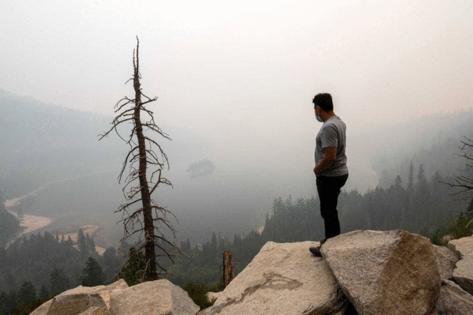Health of California's best-known lakes may have been hurt by back-to-back years of wildfire smoke
Published in Science & Technology News
Nearly every Californian can remember wildfire smoke bathing locations throughout the state in orange hues two years ago or the smell of burned wildlands wafting into their neighborhoods.
Now, researchers say the smoke could have adversely affected the state’s freshwater ecosystems.
Ashy plumes gusting from conflagrations should not be characterized as an “event” but rather now as a seasonal weather phenomenon, said Adrianne Smits, a University of California, Davis aquatic ecologist who studies at the university’s Tahoe Environmental Research Center. In 2020 and 2021, at least 70% of the Golden State was shrouded in smoke. Wildfire activity has quintupled since the 1970s, according to UC Davis.
Smits and other researchers published a study Wednesday that determined smoke alters lakes’ health by impacting components such as light, temperature and oxygen in their waters, a UCD news release said — though they noted more research was needed to determine the exact effects.
Scientists studied California’s most revered bodies of water, such as Lake Tahoe and the Sacramento-San Joaquin River Delta. There isn’t one answer as to how lakes fared under the ash and smoke during memorable fire seasons.
The waters’ quality, depth, nutrient levels and more varied across sites examined by researchers. Those differing factors, coupled with fluctuating smoke intensity, led scientists to find wildfires impacted each lake differently, the release said.
Dense ash and smoke decreased how much light reached the lake’s plant and aquatic life. Sunlight helps both to make food through photosynthesis and respiration, the release said.
“We’re seeing changes — often decreases — in photosynthesis and respiration rates that drive almost everything else,” Smits said in the release. “Food webs, algal growth, the ability to emit or sequester carbon — those are dependent on these rates. They’re all related, and they’re all being changed by smoke.”
Scientists pulled data from Castle Lake in the Klamath Mountains, Lake Tahoe and Emerald Lake in the High Sierras, Clear Lake in Lake County and a site in the Sacramento-San Joaquin River Delta. The measurements came during California’s largest wildfire season on record — 2018, 2020 and 2021, the release said.
“We’re looking at a scenario where for the next 100 years or longer, smoke will be a feature on the landscape,” Steven Sadro, a UC Davis associate professor in the Department of Environmental Science and Policy, said in the release. “What does that mean for fundamental ecology? What are the implications of those changes? Those are the big questions we’re focused on in aquatic systems.”
_____
©2024 The Sacramento Bee. Visit sacbee.com. Distributed by Tribune Content Agency, LLC.







Comments